|
The Shipping Forecast 2001-2004: Gone Fishing
For the past three years, Ninth Art's fine crew of able seamen and women have trawled the nets of papery flotsam that have washed up at the lighthouse to find the very best comics to recommend to you lucky landlubbers every week. These ancient mariners have offered reason with their rime, but every seadog has his day, so now the fishermen cast off into retirement to make way for a new team of writers next week. But of course, we couldn't let them coast away without one more shanty and a final blast of the hornpipe. There have been eleven fishermen over the years, and we reeled them all back in to pose them one simple question; What's been your favourite comic from the last three years on the lighthouse? Buoyed with enthusiasm, we now reveal eleven masterpieces to command your attention: TRAFALGAR AFTER THE SNOOTER (Eddie Campbell Comics) is and is not the fourth book in Eddie Campbell's autobiographical lifework ALEC. Having begun the telling of his life's story with the fateful words, "Danny Grey never really forgave himself for leaving Alec MacGarry asleep at the turnpike" back in 1981, Campbell continued the use of a pseudonyms for everyone involved his stories until shortly before he began self-publishing in the mid-1990s. The material collected in AFTER THE SNOOTER represents Campbell's output as an autobiographer from that point up to shortly before the volume's release in June of 2002. In this regard alone, it is a front row seat to a miracle in progress. In this same period of time, Campbell also founded a comics company, published over sixty issues of BACCHUS in an imploding direct market, completed and shepherded the publication and widespread distribution of FROM HELL to every part of the world, and adapted two more of collaborator Alan Moore's spoken word performance pieces (BIRTH CAUL and SNAKES AND LADDERS) in addition to concluding and codifying his long-running BACCHUS (aka Deadface) serial into ten collected volumes and bringing the three extant ALEC books back into print and then, just for good measure, add one more to their number. Sort of. Whatever one considers it, Campbell's autobiographical work has only grown more bittersweet with age and AFTER THE SNOOTER brings that life and that work full-circle as Campbell visits his old haunts, uncovering characters in his ongoing auto-narrative that have been flash-frozen for some readers in a literary purgatory for decades. In the end, the reader is left with a deep respect for Campbell's sophistication as a storyteller, his talent as an innovative illustrator, and his tenacity and enduring belief in the value of his own work. SHANNON
Perhaps Casey's style was too elliptical for people accustomed to the short-term crack high of the big spandex books, but for sheer craft of storytelling it was head and shoulders above every mainline title. Equal in the book's appeal were the sublime art of Dustin Nguyen, and Randy Mayor's sympathetic colouring. WILDCATS was Dustin Nguyen's first major gig, and by God did he bat it out of the park. Casey and Nguyen were a seamless combination; with some of the storytelling elements you couldn't tell whether it originated with writer or with artist. As well as the big cliffhangers, there were so many good, tiny moments. I remember an end of page zoom in on Zealot, a female character badly bloodied in a fight. The image was tight, brutal, and claustrophobic - and then you turned the page and got a full vertical panel of a tiny aeroplane in the middle of blue sky. Instant agoraphobia. I remember putting the book down at that point, and saying, "oh, yeah!" Sadly, WILDCATS was cancelled a few days ago, but it still remains a landmark in sequential storytelling, and it's well worth seeking out the two trades and the singles. FASTNET
Initially, the storyline concerned Ayers' involvement with a married woman, her children, and her ex-con husband. McNeil has expanded the setting to include other regions and societies in her complex world. She has introduced new characters, using them to explore attitudes towards life, art and - of course - sex in her world. Her existing characters age and change. Her latest story brings in yet another level to the story, with friction between the rich and poor. Like all the best science fiction, her world is a reflection of the real world. And the wonder of it all is that McNeil isn't some ivory-tower sci-fi scribe more interested in parading her research than in telling a story. Everything starts with and flows from the characters, the way they talk, and - with McNeil's fluid, cartoonist-influenced style - the way they look and move. Expressions, body language; it's all there, and it all contributes. It's exciting, sexy, warm, often very funny, and completely involving. There wasn't anything else like FINDER on the shelves when 9A came along. There still isn't. Long may it continue. PLYMOUTH
It's fascinating to watch Ito model UZUMAKI after a spiral itself, starting with the broad outer rings as the effects are relatively mild and still somewhat explainable. Then, as the story progresses, the curves and speed in which it's progressing towards its terminus increases, twisting the town and its people tighter and tighter. As people's bodies begin to spiral into snail shells, and hurricanes blast through the buildings, you begin to realise that this is no ordinary story. This is a journey into terror like you've never been on before, and by the time you really understand the spiral's path, it's too late. You're almost at the centre now, the last step before it all comes crashing to a halt. Of course, people who read UZUMAKI now have a real advantage over those who read the chapters in PULP magazine, or merely bought the collections as they were released, because they don't have to wait months to see what will happen next. If you buy the first volume and like it, listen closely: buy the second and third ones at the same time. Once you've progressed that far down the spiral, you won't want to veer off the path even for an hour to run out and buy the conclusion. But don't worry. That's what the spiral wants. VIKING
But at its heart, ALIAS was simply a cracking good read. Thanks to Brian Michael Bendis, you never knew where a story was going, and each story was an original twist on the Marvel Universe, something that hadn't been done before. Politicians using Captain America's secret identity for political gain. Deluded superhero-fanciers. And also - cutting chunks out of Spider-Girl and then smoking them. That was great, too. From start to finish, the art was flawless and expressive - I doubt one in a hundred comic characters is as believable and convincing as Jessica Jones as rendered by Michael Gaydos. There was a real feel to ALIAS that made it unique, like we were seeing something special that we won't see again. Ostensibly the title continues as THE PULSE, but to be honest, if Jessica Jones can't swear at superheroes, the magic is gone for me. I mean, they called Speedball a "fucking retard, second-string, spaz fuck of a retard super-hero". We won't see those glory days again, my friends. GERMAN BIGHT
PROMETHEA may be the greater technical achievement, TOM STRONG may be the most warm-hearted of the ABC line, but TOP TEN is... well, it's my number one. Is it a police procedural? Is it a superhero book? Well, it's both and neither. What's really important is not the genre, but the characters, and central to most of them are their identities as both policemen and superpowered beings. It's the characters that provide the focus, and the superpowered crimes that drive the plot. Combining Moore's meticulous plotting and dialogue with Gene Ha's lively and detailed art made it a satisfying read, and adding Zander Cannon's layouts, Alex Sinclair's colours and Todd Klein's lettering to the mix made it the perfect package for me. And I never even knew I was looking for that package in the first place. But everything was there - the little in-jokes in the art, the beautifully realised characters, even the perfect stand-alone issue in #8 ("The Overview"). We've even had the sequel in the form of SMAX, which made me laugh more then any comic has in a long time. For me, there's something about TOP TEN that keeps me picking it up and re-reading it even now. Perhaps because it's the perfect companion for a long afternoon - clever, good-humoured and easy on the eye. FINISTERRE
It's certainly not a serious book, and it has refined a singular sense of energy and verve, thanks to its hyperactive protagonists and its usage of the style of that most lively of comics art forms, Manga; this is no dreary rumination on the nature of death in some clinically-rendered German gutter, and thank goodness for that. Of all the books featured on the Forecast that I've read over the years, none have had the immediate and universal appeal of Clugston-Major's ongoing masterpiece. Her humour is puerile and foul-mouthed (everyone likes that), her art is vibrant and full of character (everyone likes that too), and... well, I'm sure somebody loves Seamus the giant otter. Other than my sister. FORTIES
They use Sandra's simple, iconic artwork to counterpoint John's elaborate, complicated narrative - quite the opposite of many comics, with lovely intricate art rather than grunts and ker-pows. Louis is the 'everyman', at least if you've questioned your daily life, and wondered if the people over the road are looking in through your window, and found that in fact your suspicions were at least partly true. (If this is not you, you will know someone for whom it is.) The central character is a sort of rat, living in the rat race. He is innocent, but he cannot help but feel that there is something outside of Sandra's idyllic village. He's not The Prisoner though. There's no suggestion of him being held for any reason other than to keep the village going, along with the fellow residents he never sees. So it is oddly fitting when he has more meaningful interaction with his neighbours once he is inside the asylum. For a book that looks like a child's book, there is more intelligence and charm here than many of those labelled as 'mature'. DOGGER
With artists JH Williams III, Mick Gray and Todd Klein as Alan Moore's incredibly gifted accomplices, almost every issue has had some sort of visually arresting moment that would have been impossible in any form but comics, and the fact that they've been used to convey some remarkably complex ideas about time and fiction and, yes, Alan Moore's magical cosmology, and have done so with remarkable clarity, is the mark of a work by men of serious talent at the top of their game. The collections are available in hardcover and softcover, and it's one of the few occasions where the extra price of the hardcover format is completely justified by the beauty of the work it contains. A genuine masterpiece of the form. CROMARTY There are people out there who will tell you that THE INVISIBLES doesn't make sense. That it's all a load of pretentious self-indulgence with no plot. That Grant Morrison made it up as he went along, and that a comic shouldn't try to make you feel stupid just because you haven't read Baudrillard. These people will be first against the wall, come the invisible revolution. THE INVISIBLES: THE INVISIBLE KINGDOM (DC Vertigo), the final volume of Morrison's 1500-page epic, is a postmodern meisterwerk blending magic, philosophy, pop culture, metafiction, classicism, theology, science-fiction, espionage, superheroics, sex, death and a bit of the old ultra-violence into a dense, beautiful hammer to the brain. This final collection, delayed for what seemed like decades by overly cautious bureaucracy, brought the sprawling epic to a close with the only ending that would have made any sense: a new beginning. Morrison's entire philosophy is mapped and reiterated here, complete with contrary arguments from his own characters. The result is a book that urges us to live, love and have a damn good time in the process. Nice and smooth. FISHER
Of all the songs I've heard in the past three years, of all the films I've watched and all the paintings I've seen, very few have touched me that deeply. In comics, there's one work from the past few years that has really stood out in terms of how much it affected me, and that's Scott Morse's THE BAREFOOT SERPENT (Top Shelf). Morse's tribute to another true artist, the film director Akira Kurosawa, THE BAREFOOT SERPENT borrows the images and themes of a Kurosawa picture to tell the tale of a grieving family on holiday in Hawaii, and of the curious encounters that help them to come to terms with their grief. In the vibrant paintings that bookend the story, Morse talks about Kurosawa's tremendous ability to instil his stories with humanity, and this is one thing Morse doesn't need to borrow from the late director, because it's a gift Morse also possesses. His elegant artwork is not only disarmingly charming, but remarkably eloquent. The story is simple on the surface, but the themes are powerful, and the sentiment is sincere and affecting. The past three years have seen several excellent works from Morse, from children's adventures to modern myth-making, but BAREFOOT SERPENT stands apart as his most accomplished work, and it's the comic I'll treasure most from my time on the lighthouse. The 9A Lighthouse Crew are Trafalgar, Shannon, Fastnet, Plymouth, Viking, German Bight, Finisterre, Forties, Dogger, Cromarty and Fisher. Ninth Art endorses the principle of Ideological Freeware. The author permits distribution of this article by private individuals, on condition that the author and source of the article are clearly shown, no charge is made, and the whole article is reproduced intact, including this notice. Back. |
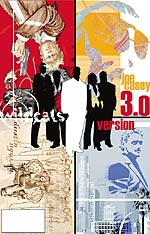 WILDCATS v3.0 (DC Wildstorm) was the Captain Sensible of superhero comics. People with unusual skills or super powers did more or less what I always thought they would do if it were real life, not funny books. No spandex. No death-rays or taking over the world. Just real characterisation, real motivations - and fantastic storytelling.
WILDCATS v3.0 (DC Wildstorm) was the Captain Sensible of superhero comics. People with unusual skills or super powers did more or less what I always thought they would do if it were real life, not funny books. No spandex. No death-rays or taking over the world. Just real characterisation, real motivations - and fantastic storytelling. 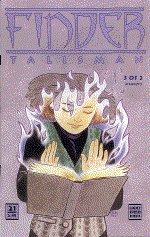 If you wanted to point to an example of how to do self-published comics, Carla Speed McNeil's FINDER (Lightspeed Press) could well be the first title on the list. It comes out regularly, both in single-issue and trade paperback format; production quality is high and consistent; and, unlike other self-publishers of genre epics, McNeil hasn't gone mad. None of this would be important unless the actual stories were also good. Fortunately, they are.
The series is set in a society of ancestral clans with traditional fixed roles, in a community of domed cities that combine ultra-high technology and a weirdly archaic way of life. It focuses on Jaeger Ayers, who embodies two traditions of a native society - a tracker of almost superhuman ability, and a ritual scapegoat for the society's wrongdoings.
If you wanted to point to an example of how to do self-published comics, Carla Speed McNeil's FINDER (Lightspeed Press) could well be the first title on the list. It comes out regularly, both in single-issue and trade paperback format; production quality is high and consistent; and, unlike other self-publishers of genre epics, McNeil hasn't gone mad. None of this would be important unless the actual stories were also good. Fortunately, they are.
The series is set in a society of ancestral clans with traditional fixed roles, in a community of domed cities that combine ultra-high technology and a weirdly archaic way of life. It focuses on Jaeger Ayers, who embodies two traditions of a native society - a tracker of almost superhuman ability, and a ritual scapegoat for the society's wrongdoings. 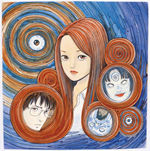 There are few books over the past three years that have so instantly affected me as Junji Ito's UZUMAKI (Viz). From the very first chapter to its finale at the end of the third volume, Ito took the concept of a town being haunted by the spirit of a spiral (or uzumaki) and brought it to life in the most horrifying manner possible.
There are few books over the past three years that have so instantly affected me as Junji Ito's UZUMAKI (Viz). From the very first chapter to its finale at the end of the third volume, Ito took the concept of a town being haunted by the spirit of a spiral (or uzumaki) and brought it to life in the most horrifying manner possible. 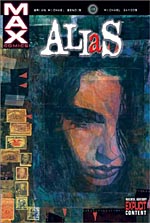 It's easy to focus on the things about ALIAS (Marvel Max) that really leap out at you - Jessica puking on Thor, Jessica saying 'fuck' to Peter Parker, and Luke Cage doing Jessica up the bum - and certainly, those are fine, fine things and they really pushed forwards the boundaries of smut and filth in comics, and that's something that's to be applauded.
It's easy to focus on the things about ALIAS (Marvel Max) that really leap out at you - Jessica puking on Thor, Jessica saying 'fuck' to Peter Parker, and Luke Cage doing Jessica up the bum - and certainly, those are fine, fine things and they really pushed forwards the boundaries of smut and filth in comics, and that's something that's to be applauded. 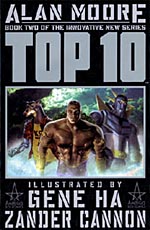 Alan Moore. If it hadn't been for him, I may never have persevered with reading comics. It's been many years since he set me on the four-colour path to geekery, but during the years that I've spent in the lighthouse TOP TEN (America's Best Comics) is the title that has most effectively wormed its way into my affections.
Alan Moore. If it hadn't been for him, I may never have persevered with reading comics. It's been many years since he set me on the four-colour path to geekery, but during the years that I've spent in the lighthouse TOP TEN (America's Best Comics) is the title that has most effectively wormed its way into my affections. 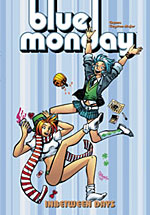 I remember being at school. I'm pretty sure that there weren't any feisty Irish girls who were really good at soccer and clobbering people, nor any amusing banter between sex-crazed teens (there was talk, but it was never amusing banter), and certainly no giant talking illusionary otters. Thankfully, Chynna Clugston-Major's magnum opus BLUE MONDAY (Oni Press) fills in the gaps, portraying a wonderfully anarchic and resonant slice of hormonal and hilarious teenage life. With otters and stuff.
I remember being at school. I'm pretty sure that there weren't any feisty Irish girls who were really good at soccer and clobbering people, nor any amusing banter between sex-crazed teens (there was talk, but it was never amusing banter), and certainly no giant talking illusionary otters. Thankfully, Chynna Clugston-Major's magnum opus BLUE MONDAY (Oni Press) fills in the gaps, portraying a wonderfully anarchic and resonant slice of hormonal and hilarious teenage life. With otters and stuff.  There's been lots of diverse stuff in my brief time on the Lighthouse. Comics with superheroes, comics with magic, comics with gods of all sorts, even comics with Scousers, written by Scousers. But the comic book that stands out for me in the past few years is on face value a rather mundane tale. It tells of a chap who ends up breaking out of the drudgery of his pointless daily work only to end up in an asylum. It's LYING TO CLIVE (Metaphrog), the second of the Louis books from the Metaphrog team, John and Sandra.
There's been lots of diverse stuff in my brief time on the Lighthouse. Comics with superheroes, comics with magic, comics with gods of all sorts, even comics with Scousers, written by Scousers. But the comic book that stands out for me in the past few years is on face value a rather mundane tale. It tells of a chap who ends up breaking out of the drudgery of his pointless daily work only to end up in an asylum. It's LYING TO CLIVE (Metaphrog), the second of the Louis books from the Metaphrog team, John and Sandra. 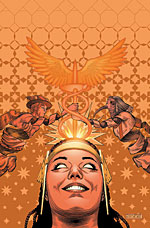 PROMETHEA (America's Best Comics), Alan Moore's last hurrah in mainstream comics, is also a very strong contender for being his best work. While it lacks the more mainstream (in the non-comics sense) appeal of FROM HELL, or the industry altering impact of SWAMP THING or WATCHMEN, PROMETHEA has been packed full of innovation purely in terms of the form.
PROMETHEA (America's Best Comics), Alan Moore's last hurrah in mainstream comics, is also a very strong contender for being his best work. While it lacks the more mainstream (in the non-comics sense) appeal of FROM HELL, or the industry altering impact of SWAMP THING or WATCHMEN, PROMETHEA has been packed full of innovation purely in terms of the form. 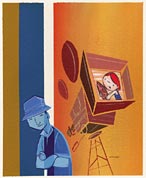 Art can provide entertainment, it can provide enlightenment, and it can provide escape. But art at its best does something more. It provides the audience with a profound experience. It burrows into the heart, it stirs the emotions, and it brings about a catharsis, a means by which to face up to our feelings.
Art can provide entertainment, it can provide enlightenment, and it can provide escape. But art at its best does something more. It provides the audience with a profound experience. It burrows into the heart, it stirs the emotions, and it brings about a catharsis, a means by which to face up to our feelings.